How can internal communications bring staff from two entities to align on a newly created brand? What can improve their engagement and collaboration amidst uncertainty?
Learn more about these questions in the 20th edition of Intraskope’s Spotlight on Internal Communication Series featuring Vija Valentukonyte of Telia, Lithuania. She discusses an award winning campaign that reduced the strain of integration, personalized communication and propelled a new brand forward. Vija follows it up with an interview on the value internal communication adds to the business and why business acumen is critical for internal communications to embrace.
Vija Valentukonyte is currently Interim Head of Corporate Communications at Telia Lietuva, the leading telco, IT and TV provider in Lithuania. She has 8 years of Communications experience in a variety of sectors and companies, such as Barclays, Lithuanian Power Co, MTV and ING Bank. Vija is passionate about change communications, as well as cultural transformation of organizations. She is also a Board member of IABC EMENA region (www.iabc.com; www.iabcemena.com) and a certified trainer helping others to be better communicators. Her work has been recognized by the Institute of Internal Communications (“30 under 30” awards 2012) and more recently with two IABC Gold Quill awards 2017 for the merger/change programs in Telia, a PR Impact award and the best HR practice award in Lithuania. She also received the Speaker of the Year 2017 award from the Lithuania HR Association.
Case Study
How an internal brand engagement can help succeed in overall rebranding process
Brands are changed overnight, although it may not feel like that. This requires thorough planning and excellent execution. Cultures are not changed overnight either – they require consistent internal communication as well as effort from the business. This case is about two well-known large telecom companies in Lithuania – incumbent telco/internet/IT/TV company Teo and a mobile provider Omnitel (both part of Telia Company group) that announced a decision to join forces in October 2015.
Change is unsettling for employees, and the actual merger was still far away – with companies, systems, contracts and brands separate. To reduce the stress of integration, to unite and inspire both teams to create a new-generation business, embed a new culture and set the stage for the upcoming rebranding we launched “Telia” brand internally in 2016. This is where internal communications enabled the integration in terms of uniting the two teams way before any physical signs of merger were visible.
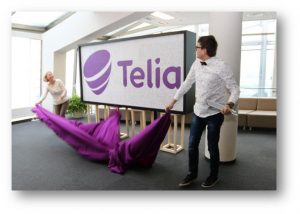
The Intervention
The companies together had 3000 employees, and therefore it was absolutely understandable that the announcement of “joining forces” in Oct 2015 would cause a lot of stress and uncertainty among employees. With a diverse employee base, the campaign had to reach all employees in their locations. The key parts of the campaign were:
1) Understanding where and how many employees worked in each 70+ places;
2) The work they were doing – 2000 office employees in the contact center, 500 engineers and 600 shop staff. For each audience, we had to make sure the activities made sense. However, we had to be mindful to avoid confusing customers, who needed to be supported well.
3) Managers and ambassadors: the influencers who are driving the new-generation telco forward.
Rebranding and merger of large organizations can be done in two ways – one way is changing all the logos and then step-by-step integrating the inside (employees, products, systems, brand proofs among others). Another way is planning more time, but also having an approach such that the business proves to customers that the new brand meant something more than a new colorful logo.
“Telia” chose the second option. At the point of time the only aspect in common between “Teo” and “Omnitel” was the Group’s Purpose and Values, while companies, systems, contracts and brands were separate. With the anticipation that “Telia” in the end will be the name of the merged business, management team in Lithuania made an unpopular decision to launch this brand internally almost a year earlier than externally. Throughout the year this was supported by consistent internal communications strategy around Values and Behaviours, to make sure that employees create the loved brand, and not the logo. This was the strategy to reduce stress, inspire employees and set the scene for the actual merger and rebranding.
The key messages of the whole Internal branding campaign were:
- Teo and Omnitel is now one family and living in one “Telia” home, while nothing changes for the customer.
- We are all creating it together, this is the place to work at right now
- This is who we want to be – playful, digital and daring
And these are the activities we have kicked off to bring those messages to life:
1) The “Telia” Launch – A Day with Telia.FM: The main campaign when Telia was presented internally for the first time. The key of this project was an outstandingly original, combined face-to-face and digital communication, exceeding all targets set. It managed to engage hearts and minds of all 3000+ employees in their 70+ work locations, and instilled the spirit of the new culture. Later on, this was supported by innovative engagement initiatives that supported the new brand promise and corporate values. A special web was programmed to replace intranet with a radio webcast for the whole day. Presents were put on everyone’s desk a night before. The facts that every employee should get involved and also receive some physical present, were the most challenging due to the geographical spread of the locations. A promo team was hired to support and also manage the activities on the day itself.
2) All-employee summer event “Telia Discovery Valley”: This was not a regular event with a few bands and sports games. There was a mobile app built especially for this summer event, which automatically mixed employees from both entities. All activities had a digital aspect – teams had a chance to contest in Virtual Reality Battles, create structures with 3D pencils and much more. There was no “them” and “us” heard in that event, and 1000+ people didn’t even mind that it rained all day long.
3) Values and behaviours program: “I create the loved brand” – this program was a result of discussions about how we’ll merge the two customer service standards into one, how we will align the KPIs and what the new Telia voice customers will hear. Based on our values, 9 behaviours were born. There was a special program set up to invite people to “try out” these behaviours, reflect on what they meant, and also commit to it through an “I Will” social media campaign.
4) Employee involvement in the brand launch (Pebble Mania): As the rebranding approached, employees were involved in giving a small surprise to customers – like giving a colourful balloon in the streets or a flashmob in Central station. This has reached its peak in February 2017 – just after overnight rebrand when large part of organisation worked multiple hours in a row. A “Pebble mania” event organized to say thank you for everyone helped reinforce the commitment of the brand.
5) Ambassadors program “Telia Fans” and Leadership program “Purple Boost”: We joined activities of Communications and HR to activate the culture through the ones who are assigned or informal leaders.
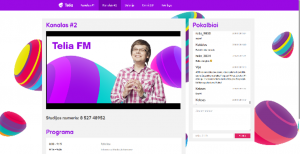
Your/team’s role in crafting a solution
From brief to the day of the brand launch campaign we had 3 and a half weeks. We involved an agency to create the solution. It involved multiple steps which all connected and showed a cohesive effort:
- A special web was programmed to replace intranet with a radio webcast Telia.FM for the whole day. Perfect way to involve but not to overtake attention yet instil a celebration mood.
- The branded presents were put on everyone’s desk a night before.
The fact that every employee should get involved and also receive some physical present, were the most challenging due to so many locations. We hired a promo team and also managed the activities on the day itself. Every employee got to sign a little magnet that contributed to a large puzzle.
The Q&As were sent out to everyone to make sure all understood the brand guidelines.
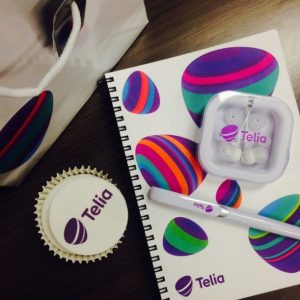
The impact
1) 85% of employees have evaluated “Telia” brand positively
2) 1500+ employee posts with the Telia hashtag after the official brand launch
3) One fifth of employees posted their “I WILL” pictures on social media
4) “I create the loved brand” – average evaluation of the event is 4.7 (on a scale of 1 to 5 where 5 is the highest), and 1800 employees attended these events. The behaviours were basis for the Quarterly employee awards and the way front line staff got assessed. What’s more, they suggested the idea of using behaviours as a guide!
5) The emotion from employees was extremely positive. The employee engagement survey has reached its peak of 82% in 2016. Usually the engagement rates fall during mergers.
6) Finally – the business results. We reached 91% brand awareness in the market in two months. That meant that we have almost got back to where Teo and Omnitel brands were in terms of market awareness. The Brand Love Index had touched the highest scores the old brands had, and throughout the year it had increased by a third! Not to say that we had managed to keep the businesses stable and in both 2001 and 2017 we achieved our financial targets.
How it changed the way stakeholders perceived your team
Firstly, it was the visibility. Internal communications often tend to be a gap-filler for all things that no one else is ready to pick up. While doing campaigns like these we were a true strategic link to the business results. We gained trust that internal communication can have the same leverage as external communications. And yes, it also increased expectations of us. The team still received requests to make any internal communications as a campaign so that everyone is excited. Yet, it is important to be aware that any initiative requires resources – be it a team, agencies and funding – to get the effect that you actually want.
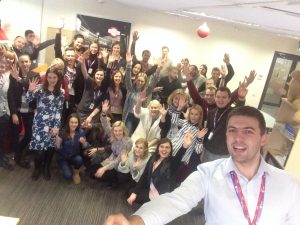
Your personal learning which other practitioners can benefit from
I think the key is to understand what the business wants to achieve and make it happen. Whatever it takes, by making it the focus. And for truly big initiatives – don’t be afraid of using the same resources external communications uses – such as creative agencies. Make sure you brief them well. We in internal communication often think that we are to do everything by ourselves. With internal and external communication blending, the boundaries become fuzzy. I think it is time to change this attitude.
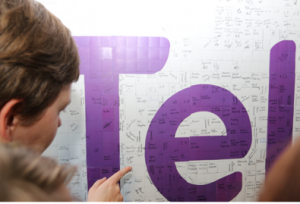
What would you have done differently if you were to revisit the campaign?
I would have bought more time 🙂 Really some of the actions required lots of energy from the team and I, than any other project.
This internal communication campaign received IABC’s Gold Quill Award of Excellence in 2017, International PR Impact Awards in Lithuania 2017 and got shortlisted for CEB Internal Communications Awards in 2017.
Interview
- What does internal communication mean to you?
For me internal communication is the key to help organizations understand their direction and drive action to it. I was never a fan of “let’s make more and more interesting content”, or “let’s try this new tool for communication” if that doesn’t add value to the business results.
- How is it practiced in your organization?
In Telia, I’m very happy that it is considered one of the strategic functions; where internal communications is involved in forming the organization’s culture, as well as forming the leadership communications to drive strategy forward.
Another trend that is very common is that internal and external communication are blending together as a much more complex communication function, because any employee can also take part in company’s external communication.
- Please share an example/campaign that you are personally proud of working on and that made a significant impact to your organization.
The biggest highlight of the recent two years, of course, has been the integration of two companies and two cultures, which included all aspects of strategic communication – including change management, leadership communication, employee engagement and driving the rebranding inside-out.
- What is the biggest challenge you face while going about managing internal communication?
The most important focus for any internal communicator is to keep up with what is going on in the business, its environment, and make sure you are addressing the actual problem the business is trying to solve. What you will notice, is that IC is one of the disciplines where everyone has an opinion on how it should be done, and it is very easy to slip into a doer, content-generator role which doesn’t always add value. So keeping an eye on the value you’re creating and saying NO in the right way at the right may save your day, and also the resources of the business.
- What according to you is the biggest opportunity that internal communicators have?
To make project that matter, that build business that earn more money or any other measurable results. Even better employee engagement has to bring benefits to the business, and that is something that has to be proved regularly. Otherwise internal communications runs a risk of being treated as an overhead, while it definitely is not. What is more, because of the VUCA world we’re currently operating in, none of the organizations can afford to trust one leader to know it all about business – which makes organizations less hierarchical, and more of the social networks – and I see internal communicators as the first people to make sure the insights from those networks reach the decision makers in any business.
- How can internal communicators add more value to the business?
The best projects that brought the most value to the organization so far in my career have been done in collaboration with different divisions – HR, Brand, Marketing, or Customer Experience. I believe no communication can exist as an island, you always have to be in touch with the pulse of the business.
- What is your advice for people who are keen to join internal communication and make a career? What skills must they have or develop?
Definitely develop business acumen, as this is the only way you can support the business in the most efficient way. It is exciting in Internal Communications that you can deal with all types and levels of people in the organisation, and it is also part of becoming a trusted partner. Other than that, there are regular communicator’s skills, like writing, storytelling, planning and organizational skills.
Missed previous stories from organizations featured on the Intraskope’s Spotlight on Internal Communication Series? Look them up here – Infosys, SOBHA Ltd., ICICI Securities, First Advantage, CK Birla Group, TVS Motors, GE, Suzlon, Tata Sons, Percept, Knight Frank, TCS Europe, Vedanta, Oxfam, Danske Bank, Diageo, Pandora, Symantec and ISS Global Services.
Intraskope (www.aniisu.com) is the first blog on internal communications in India and among the earliest around the globe. Begun in 2006, the blog has over 550 posts on topics such as employee engagement, leadership communication and employee branding and receives thousands of visits from across the world. The blog, receives over 50,000 visits every month from over 50 countries globally, offers learning resources for practitioners, academicians, and students including industry workshops, research reports, and checklists. Intraskope has been featured on leading global internal communication forums like Simply-Communicate, IC Kollectif and International Association of Business Communicators. It is hosted by Aniisu K Verghese, author of Internal Communications – Insights, Practices & Models (Sage, 2012).
If you are an internal communication leader working in a firm or a not-for-profit anywhere in the world and have an internal communication case study, campaign, research insight or a guest blog post to share, please contact me on [email protected]
You can also visit my website www.intraskope.com and You Tube channel to know more.
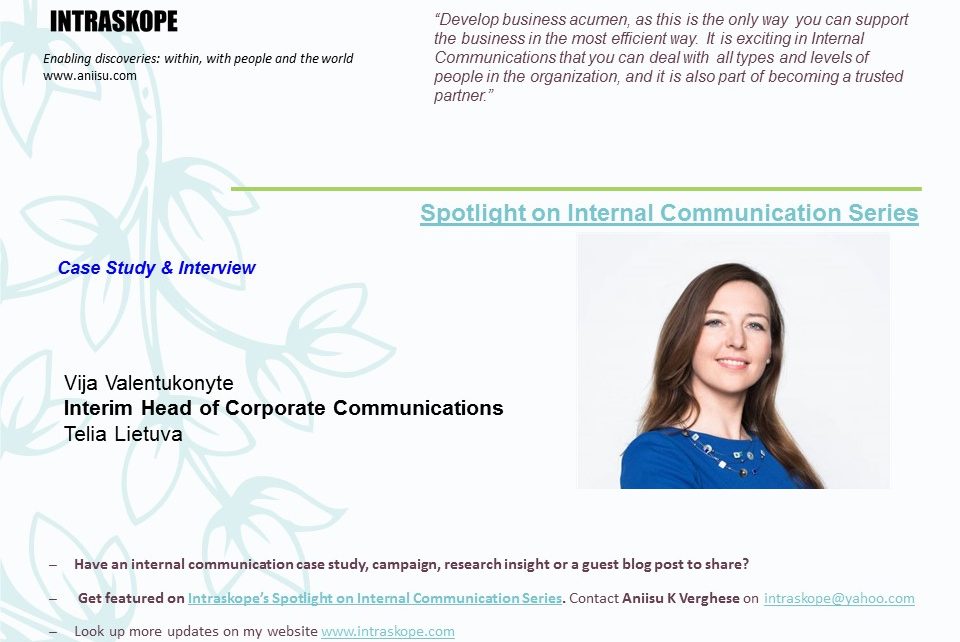

This is one of the best case studies. Change communication is the toughest part in this field. But, the best practices followed in Telia, are the great learning for any passionate internal communicators. Thanks for sharing this case study.